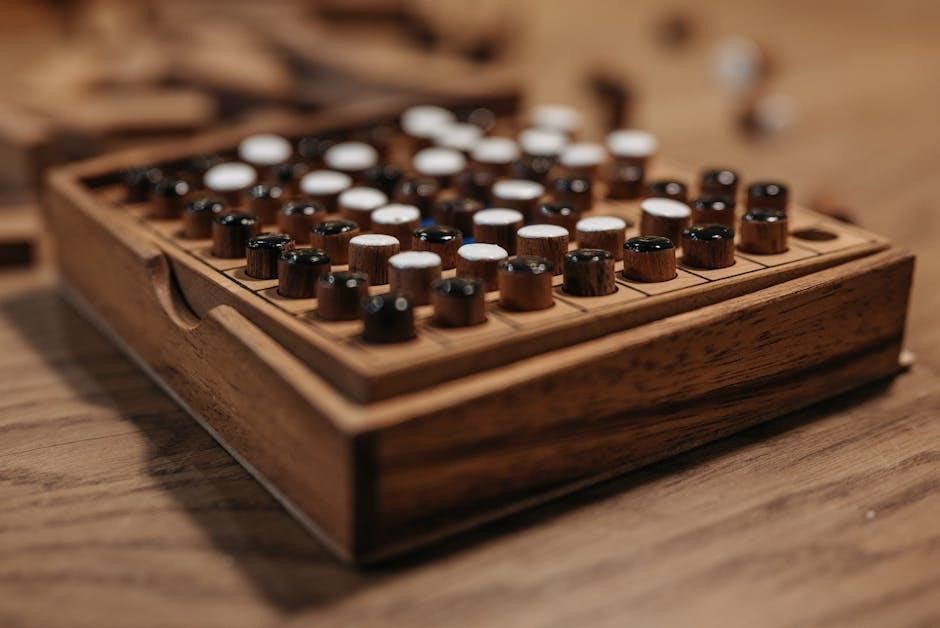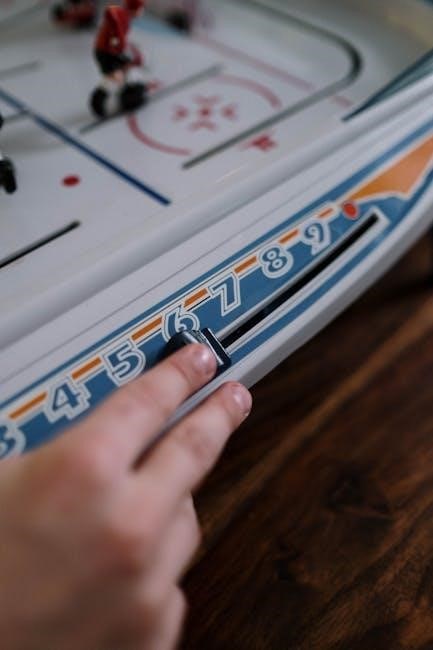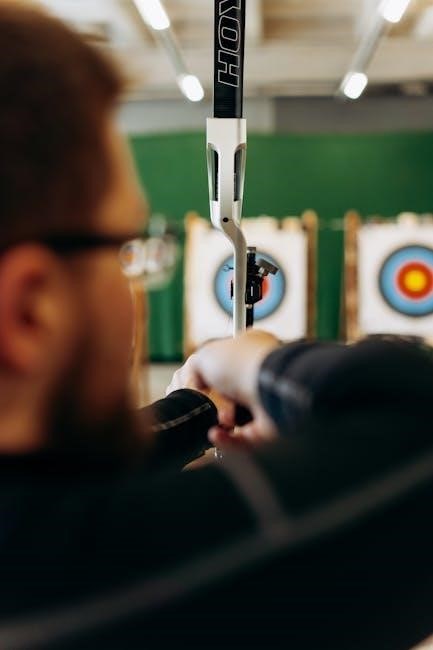ghost recon breakpoint trophy guide
Welcome to the Ghost Recon: Breakpoint Trophy Guide, your comprehensive resource for earning every Platinum, Gold, Silver, and Bronze trophy in the game. This guide provides detailed strategies, tips, and requirements to help you unlock all achievements efficiently, whether you’re a seasoned player or new to the series.
Overview of the Game and Trophy System
Ghost Recon: Breakpoint is a tactical third-person shooter with a strong emphasis on storytelling, exploration, and multiplayer cooperation. The game features a variety of trophies, including Platinum, Gold, Silver, and Bronze, each requiring specific achievements. The trophy system is designed to reward both completionists and casual players, with challenges ranging from completing story missions to destroying enemy drones. The game offers a mix of single-player and co-op objectives, with some trophies requiring online play. Overall, the trophy system provides a balanced difficulty curve, with an estimated completion time of 35-45 hours for 100% completion. This guide will help you navigate the requirements and strategies for each trophy efficiently.
Importance of Trophies in Ghost Recon: Breakpoint
Trophies in Ghost Recon: Breakpoint serve as a rewarding way to track progress and showcase achievements. They add depth to the gameplay experience by encouraging players to explore different aspects of the game, such as completing story missions, mastering classes, and experimenting with various combat strategies. Earning trophies also provides a sense of accomplishment and completion, especially for dedicated players aiming to unlock the Platinum Trophy. Additionally, trophies foster competition and camaraderie among players, as they compare progress and share tips. Overall, the trophy system enhances the game’s replayability and offers a clear path for players to challenge themselves and fully experience everything Ghost Recon: Breakpoint has to offer.

Platinum Trophy
Earning the Platinum Trophy in Ghost Recon: Breakpoint signifies completing all other trophies, showcasing mastery of the game’s story, challenges, and multiplayer modes.
Breakpoint Trophy: Reach the End of Act 4
Obtaining the Breakpoint Trophy requires completing the game’s main story by reaching the end of Act 4. This involves progressing through the narrative, overcoming challenges, and defeating key enemies. Ensure you follow the storyline diligently, completing all required missions and side objectives. Stay updated with your gear and abilities to tackle tougher foes. This trophy is story-related and cannot be missed, but it demands perseverance and dedication. Completionists should also focus on optional dialogues and quests in Erewhon to fully immerse in the story; Once Act 4 concludes, the trophy unlocks, marking a significant milestone in your journey toward the Platinum Trophy.
Gold Trophies in Ghost Recon: Breakpoint offer challenging key achievements that test your combat skills and persistence, including ‘Jack of All Guns’ and ‘Drone Farmer’ trophies.
Jack of All Guns: Kill an Enemy with Every Firearm Type
To unlock the Jack of All Guns trophy in Ghost Recon: Breakpoint, you must kill an enemy with every firearm type in the game. This includes assault rifles, sniper rifles, SMGs, shotguns, handguns, and launchers. To achieve this efficiently, use the weapon blueprints feature to track which types you’ve used. Experiment with different weapons in various missions, and consider switching weapons after each kill to avoid respawning enemies. Focus on rarer weapon types first, like launchers, to ensure completion. This trophy requires patience and exploration of the game’s arsenal.
Drone Farmer: Destroy 50 Enemy Drones
To earn the Drone Farmer trophy in Ghost Recon: Breakpoint, you must destroy 50 enemy drones. Drones are commonly found in enemy patrols or near key objectives like resource convoys or outpost defenses. Use rocket launchers or precision strikes to take them down quickly. The sync shot ability in co-op is highly effective for this. Focus on completing missions in areas with high drone activity, such as the Auroa Archipelago’s industrial zones. Replay missions with frequent drone spawns to maximize efficiency. Keep track of your progress, as this trophy requires consistent effort over time. Destroying drones also helps reduce enemy awareness, making it a strategic advantage.
Silver Trophies in Ghost Recon: Breakpoint represent moderate achievements, focusing on skills like synchronized kills, class mastery, and strategic gameplay. Earn these to showcase versatility and progression.
Synchronized and Deadly: Kill an Enemy Shortly After Another Player in Co-op
To unlock the Synchronized and Deadly trophy, coordinate with a co-op partner to eliminate enemies in quick succession. This achievement requires seamless teamwork and timing, ensuring one player’s kill is immediately followed by another’s. Communication is key; use pings or voice chat to synchronize attacks. Opt for classes with high damage output or stealth abilities to execute enemies swiftly. Focus on densely populated areas or missions with multiple hostiles to maximize opportunities. Patience and practice will help you master this trophy, showcasing your ability to work strategically in a team environment.
Absolute Mastery: Reach Rank 10 with Any Class
To earn the Absolute Mastery trophy, you must reach Rank 10 with any class in Ghost Recon: Breakpoint. This requires consistent progression through the game, completing missions, and engaging in activities that grant XP. Focus on main story missions and side objectives to accumulate experience efficiently. Additionally, participating in multiplayer modes and daily challenges can accelerate your progress. Each class has unique abilities, so experiment to find the one that suits your playstyle. Regularly equip better gear and optimize your loadout to enhance performance. Tracking your progress through the in-game menu will help you stay motivated. Dedication and persistence are key to achieving this milestone.

Bronze Trophies
Bronze Trophies in Ghost Recon: Breakpoint include achievements like completing story missions, finding weapon attachments, and destroying enemy drones. These trophies offer a variety of challenges, from combat and exploration to story engagement, ensuring a well-rounded experience for players aiming to unlock them all.
Complete the Story Missions
Complete the Story Missions is a bronze trophy in Ghost Recon: Breakpoint that requires players to finish the main campaign. This trophy is straightforward, focusing on progression through the game’s narrative. To unlock it, simply play through and complete all the story missions in each act. The trophy doesn’t require any specific gameplay style or difficulty level, making it accessible to all players. It’s a great way to immerse yourself in the game’s universe while working toward your platinum trophy. Make sure to follow the main objectives and enjoy the story as you progress through the campaign.
Find 30 Weapon Attachments and Equip One
Find 30 Weapon Attachments and Equip One is a bronze trophy that encourages players to explore the world and customize their weapons. Weapon attachments are scattered across the map in chests, enemy camps, and hidden locations. Use your drone to scan areas and highlight loot containers. Once you’ve collected 30 attachments, equip one to your weapon to unlock the trophy. This trophy promotes exploration and preparation, as having the right gear is crucial for survival. Keep an eye out for rare attachments to maximize your weapon’s effectiveness and complete this trophy efficiently while progressing through the game.
Destroy a Farmer Drone
Destroy a Farmer Drone is a bronze trophy that tasks players with eliminating one of these aerial support drones. Farmer Drones are automated enemies that patrol specific areas, often providing intel or reinforcements to hostile forces. To destroy one, use anti-air weapons like rocket launchers or high-damage sniper rifles. These drones can be found in regions like the Auroa Archipelago, particularly during story missions or in enemy-heavy zones. Once destroyed, the trophy unlocks. This achievement highlights the importance of adapting to enemy tech and using the right gear for the job. Precision and quick reflexes are key to taking them down before they escape or call reinforcements.
Complete the Optional Dialog in Erewhon About Your Past
Complete the Optional Dialog in Erewhon About Your Past is a bronze trophy tied to engaging with the game’s narrative. In Erewhon, the main hub area, players can interact with non-playable characters (NPCs) to uncover more about their character’s backstory. This trophy requires initiating and completing a specific optional conversation that delves into the protagonist’s past. These dialogues are marked on the map and provide deeper insight into the story. Engaging with these moments enhances immersion and rewards players with this achievement. It’s a straightforward trophy that encourages exploration of the game’s lore and character development.
World 2.0 Kill Walker
World 2.0 Kill Walker is a bronze trophy in Ghost Recon: Breakpoint that tasks players with defeating a challenging enemy known as the Walker. This trophy is tied to progressing through the game’s story and encountering this formidable opponent. The Walker is a heavily armored drone that requires strategic gameplay to take down. Players must utilize cover, precise shooting, and effective use of abilities to weaken it over time. Successfully defeating the Walker not only unlocks this trophy but also advances the narrative and rewards players with valuable loot. This achievement highlights the game’s emphasis on tactical combat and perseverance against tough adversaries.
Tell Your Story
Tell Your Story is a bronze trophy in Ghost Recon: Breakpoint that focuses on progressing through the game’s narrative and building your character’s identity. To unlock this trophy, you must reach maximum reputation with a faction, specifically Skell Technology. This involves completing faction-specific missions, side activities, and engaging in dialogue choices that align with their goals. The trophy emphasizes the role-playing aspect of the game, allowing players to shape their character’s backstory and motivations. By fostering strong relationships with factions, you not only unlock this achievement but also gain access to exclusive rewards and story content. This trophy rewards players for immersing themselves in the game’s lore and building connections within the world of Auroa.
Cold Steel
Cold Steel is a bronze trophy in Ghost Recon: Breakpoint that challenges players to defeat a Walker without the assistance of drones. This trophy requires strategic planning and precise execution, as Walkers are heavily armored enemies. To unlock it, players must target the Walker’s weak points, such as its legs and core, using powerful weapons like rocket launchers or heavy machine guns. The trophy tests skill and patience, encouraging players to rely on their combat abilities rather than relying on drone support. Completing this achievement rewards players with a sense of accomplishment and progresses them toward the platinum trophy. It’s a great way to showcase tactical prowess in the game.
Max Scout
Max Scout is a bronze trophy in Ghost Recon: Breakpoint that focuses on maximizing the potential of the Scout drone. To unlock this achievement, players must upgrade their Scout drone to its highest level by completing various missions and defeating enemies. The drone plays a crucial role in reconnaissance, marking enemies, and providing tactical advantages. Upgrading it enhances its durability, speed, and ability to detect hidden foes. Achieving this trophy demonstrates mastery of the drone system and contributes to overall progression. It’s a rewarding milestone that highlights the importance of strategic gameplay and resource management in the game.

Trophy-Specific Guides
Discover detailed strategies and tips for achieving every trophy in Ghost Recon: Breakpoint, ensuring efficient progression and mastery of the game’s challenges.
You Monster Trophy: Destroy a Farmer Drone
The You Monster trophy requires players to destroy a Farmer Drone in Ghost Recon: Breakpoint. Farmer Drones are automated machines that collect resources across Auroa. To unlock this trophy, locate a Farmer Drone, often found near resource-gathering points or in areas like Erewhon. Use weapons or explosives to destroy it. Note that using an EMP Drone to disable it won’t count, so direct damage is essential. This trophy is straightforward and can be completed early in the game. Ensure you’re equipped with sufficient ammo or explosives for a quick takedown. Completing this achievement rewards you with a bronze trophy and progresses your journey toward the platinum.
Cold Steel Trophy: Achievement Details and Requirements
The Cold Steel trophy in Ghost Recon: Breakpoint is awarded for achieving 50 melee kills. To unlock this bronze trophy, players must eliminate enemies using hand-to-hand combat. Melee kills are most effective in close-quarters situations, and stealth takedowns are ideal for consistent progress. Equip a melee weapon or use the default combat knife to perform these kills. Enemies can be stunned with a non-lethal takedown or killed instantly with a lethal one. This trophy is straightforward but time-consuming, requiring patience and strategic play. It contributes to the overall platinum trophy and showcases mastery of close-range combat. Complete this achievement to earn your bronze reward and move closer to 100% completion.
Collectibles and Challenges involve finding hidden intel, Blueprints, and completing specific in-game tasks. These elements enhance progression, unlock gear, and provide additional lore. They are scattered across Auroa.
Ghost Recon: Breakpoint Infinity Collectibles Locations are scattered across Auroa, offering intel, Blueprints, and other hidden items. These collectibles are essential for progression, as they unlock gear and provide lore. Key locations include military bases, enemy camps, and hidden caves. Players can use drones to scan areas or complete missions to reveal locations. Community-shared maps and guides are invaluable for tracking down elusive items. Finding all collectibles requires thorough exploration and strategic planning. This challenge adds depth to the game, rewarding dedication and attention to detail. Mastering the art of discovery is crucial for 100% completion and maximizing your tactical advantage.
All Collectible Locations Guide for PlayStation 4, PC, Xbox One helps players track down every Blueprint, intel, and hidden item in Ghost Recon: Breakpoint. Each platform version has identical collectible locations, ensuring a uniform experience. Military bases, enemy camps, and remote areas like caves and ruins are hotspots for these items. Use your drone to scan for hidden caches or follow community-shared maps to pinpoint locations. Completing your collection unlocks exclusive gear and provides a deeper understanding of Auroa’s lore. This guide is your roadmap to 100% completion, ensuring no collectible is left behind across all platforms.

Achievement Guide
Achievement Guide provides a comprehensive overview of earning every accomplishment in Ghost Recon: Breakpoint, covering combat, exploration, and challenges to help players unlock all rewards efficiently.
100% Achievement Guide for Ghost Recon: Breakpoint
To achieve 100% in Ghost Recon: Breakpoint, complete all story missions, side quests, and optional dialogues. Collect 30 weapon attachments and equip one to unlock specific trophies. Destroy enemy drones, including the Farmer Drone, to progress through challenges. Reach rank 10 with any class to demonstrate mastery; Utilize co-op mode to earn trophies like Synchronized and Deadly. Explore the map thoroughly to find collectibles and complete world activities. Focus on varied combat tactics to kill enemies with every firearm type. Regularly save progress to avoid losing achievements. Stay patient and strategic, as some trophies require multiple playthroughs or specific in-game actions. Use cover effectively to survive and complete difficult missions.
How to Get Every Achievement in the Game
To unlock every achievement in Ghost Recon: Breakpoint, focus on completing all story missions, optional dialogues, and side quests. Explore the open world to locate collectibles like weapon attachments and intel. Destroy enemy drones, including the Farmer Drone, to progress through specific challenges. Achieve rank 10 with any class to showcase mastery. Participate in co-op missions to earn trophies like Synchronized and Deadly. Save frequently to avoid losing progress; Use tactical combat strategies and cover mechanics to survive tough encounters. Experiment with different weapons and tactics to kill enemies with every firearm type. Stay persistent, as some achievements require multiple playthroughs or precise actions.

Tips and Tricks

Use cover effectively, plan with your team, and stay stealthy to avoid enemy detection. Experiment with weapons and classes to find your optimal playstyle for trophy success.
Beginner’s Guide to Ghost Recon: Breakpoint
Mastering the basics is key to progressing smoothly. Start by completing the in-game tutorials to understand movement, combat, and tactical gameplay. Prioritize resource gathering to upgrade gear and unlock new equipment. Exploration is crucial—use your drone to scan areas, mark enemies, and locate collectibles. Equip weapons that suit your playstyle, and experiment with different classes to find your strengths. Stay stealthy whenever possible, as open combat can be overwhelming early on. Communicate with your team in co-op to execute strategies effectively. Regularly check your map for side missions and objectives to ensure you’re on track for trophy completion.
How to Earn the Platinum Trophy Efficiently
To efficiently earn the Platinum Trophy in Ghost Recon: Breakpoint, focus on completing all story missions, side quests, and optional objectives. Prioritize upgrading your gear and skills early to tackle tougher challenges. Complete collectibles and challenges, such as destroying drones and mastering weapon types. Play co-op for trophies requiring teamwork. Avoid repeating tasks and use guides to locate collectibles quickly. Stay patient and methodical—missing trophies can be collected in post-game. By balancing exploration, combat, and progression, you’ll streamline your path to the Platinum Trophy without unnecessary grinding.

Online and Offline Trophies
Offline Trophies: 46, including story-related and single-player achievements. Online Trophies: 5, requiring multiplayer interaction or co-op play to unlock.
Offline Trophies: 46 (1, 2, 8, 35)
The offline trophies in Ghost Recon: Breakpoint total 46, offering a variety of challenges for solo players. These include 1 Platinum, 2 Gold, 8 Silver, and 35 Bronze trophies. Many of these are tied to the game’s single-player campaign, such as completing story missions, reaching specific ranks, and achieving certain in-game feats. Offline trophies also reward exploration, skill mastery, and completion of optional objectives. Players can focus on these without needing multiplayer interaction, making them accessible to those who prefer a solo experience. Earning these trophies requires dedication and a thorough exploration of the game’s world and mechanics.
Online Trophies: 5 (1, 4)
The online trophies in Ghost Recon: Breakpoint consist of 5 achievements, with 1 Platinum and 4 Gold trophies. These require players to engage in multiplayer modes, emphasizing teamwork and strategy. Earning these trophies involves completing challenging co-op missions, achieving specific objectives in multiplayer matches, and demonstrating exceptional skill in collaborative gameplay. Unlike offline trophies, these require interaction with other players, adding a dynamic and competitive layer to the game. While the majority of trophies are obtainable offline, these online achievements offer a unique way to test your abilities alongside or against other players, enhancing the overall gaming experience and fostering a sense of community among players, which is essential for achieving these challenging multiplayer goals and showcasing teamwork prowess, all while contributing to your overall trophy collection.

Time and Difficulty
Estimated time to 100%: 35-45 hours. Achievement difficulty rating: 3/10. The game’s depth and specific trophy requirements may extend playtime and challenge players moderately.
Estimated Time to 100%: 35-45 Hours
Completing Ghost Recon: Breakpoint to 100% requires approximately 35-45 hours, depending on skill level and gameplay style. The main story and side missions form the core, while collectibles, optional dialogues, and specific trophy requirements add depth. Some trophies, like killing enemies with every firearm or reaching rank 10 with a class, demand additional time. Players with higher skill levels may complete tasks faster, while newcomers might need more time to master mechanics. Co-op play can also speed up progress for certain achievements. Overall, the game offers a balanced challenge, making it achievable within the estimated timeframe for dedicated players.
Achievement Difficulty Rating: 3/10
The achievement difficulty in Ghost Recon: Breakpoint is rated 3/10, making it relatively accessible for most players. Many trophies are straightforward, such as completing story missions or reaching specific ranks. Some achievements, like killing enemies with every firearm type, require attention to detail but aren’t overly challenging. The game’s design allows players to progress naturally, with most achievements unlockable through normal gameplay. Co-op play also simplifies certain tasks, like synchronized kills. While a few trophies may demand specific strategies, the overall list is manageable with basic skill and patience. Dedicated players can efficiently unlock all achievements without extreme difficulty.

FAQ and Common Issues
- Trophies not unlocking? Check server status and game updates.
- Missing collectibles? Use in-game tools to locate them.
- Co-op issues? Ensure all players have the same game version.
Frequently Asked Questions About Trophies
Players often ask about trophy progress not saving, which can be resolved by ensuring a stable internet connection and checking Ubisoft server status.
Hidden trophies, like World 2.0 Kill Walker, can be confusing. Focus on completing story missions and exploring the map thoroughly.
Collectible-related trophies, such as finding 30 weapon attachments, require patience. Use the in-game map and drone to locate hard-to-find items.
Co-op trophies, like Synchronized and Deadly, may not unlock if players aren’t in the same party or if the host quits early.
Missable trophies, such as story-related ones, cannot be replayed after completing the campaign, so ensure all tasks are done before the final mission.
Trophy synchronization issues can occur but are usually fixed by restarting the game or rechecking completion criteria.
Known Bugs and Fixes for Trophy Unlocking
Some players have reported issues with trophies not unlocking, even after meeting requirements. This is often due to server-side problems or game glitches.
To fix this, restart the game, ensure Ubisoft Connect is updated, and check server status. For progress loss, reload a previous save or replay the mission.
Co-op trophies may fail to unlock due to connectivity issues. Ensure a stable internet connection and that all players meet the criteria simultaneously.
Buggy trophies like Drone Farmer or Jack of All Guns may require multiple attempts. Restarting the game or replaying specific missions can resolve this.
For persistent issues, verify game files through your platform’s settings and avoid using exploits, as they may block trophy progress.
Ubisoft support can assist with unresolved cases, so contact them if problems persist.
Final Thoughts on Completing the Trophy Set
Completing the Ghost Recon: Breakpoint trophy set is a rewarding journey, requiring skill and dedication. Each achievement adds depth to your experience, showcasing mastery of the game.
Congratulations on completing the Ghost Recon: Breakpoint trophy set! This achievement showcases your dedication, skill, and mastery of the game’s mechanics. The journey through the story, side missions, and challenges is a testament to your perseverance. Each trophy, from the platinum to the bronze, represents a milestone in your adventure. Embrace the sense of accomplishment and reflect on the memorable moments you’ve experienced. Whether you’re a completionist or a casual player, this feat highlights your commitment to excellence. Take pride in your progress and enjoy the satisfaction of a job well done in this immersive tactical world.










